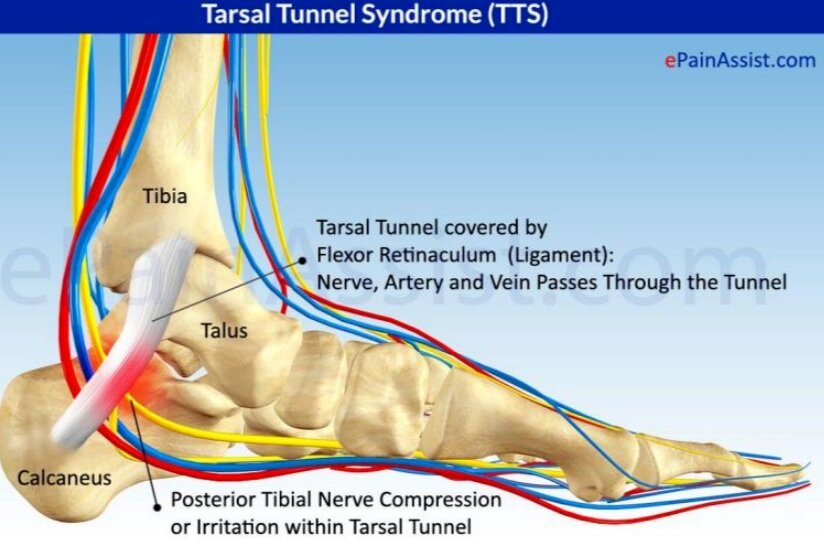Our Podiatrists Specialize in Tarsal Tunnel Syndrome Treatment servingTorrance, San Pedro & Los Angeles area
TARSAL TUNNEL SYNDROME
What Is the Tarsal Tunnel?
The tarsal tunnel is a narrow space that lies on the inside of the ankle next to the ankle bones. The tunnel is covered with a thick ligament (the flexor retinaculum) that protectsand maintains the structures contained within the tunnel-arteries, veins, tendons, and nerves. One of these structures is the posterior tibial nerve, which is the focus of tarsal tunnel syndrome.
What Is Tarsal Tunnel Syndrome?
Tarsal tunnel syndrome is a condition caused by repeated pressure that results in damage on the posterior tibial nerve. Your tibial nerve branches off of the sciatic nerve and is found near your ankle. Tarsal tunnel syndrome is similar to carpal tunnel syndrome, which occurs in the wrist. Both disorders arise from the compression of a nerve in a confined space. Although tarsal tunnel syndrome may not be as well-known as carpal tunnel syndrome, it is nevertheless a cause of foot and ankle pain in adults.
Symptoms
Patients with tarsal tunnel syndrome experience one or more of the following symptoms:
Tingling, burning, or a sensation similar to an electrical shock
Numbness
Pain, including shooting pain the symptoms are typically felt on the inside of the ankle and/ or on the bottom of the foot. In some people, a symptom may be isolated and occur in just one spot. In others, it may extend to the heel, arch, toes, and even the calf.
Sometimes the symptoms of the syndrome appear suddenly. Often they are brought on or aggravated by overuse of the foot- such as in prolonged standing, walking, exercising, or beginning a new exercise program. It is very important to seek early treatment if any of the symptoms of tarsal tunnel syndrome occur. If left untreated, the condition progresses and may result in permanent nerve damage. In addition, because the symptoms of tarsal tunnel syndrome can be confused with other conditions, proper evaluation is essential so that a correct diagnosis can be made.
Causes
Tarsal tunnel syndrome is caused by anything that produces compression on the posterior tibial nerve, such as:
A person with flat feet is at risk for developing tarsal tunnel syndrome, because the outward tilting of the heel that occurs with "fallen" arches can produce strain and compression on the nerve.
An enlarged or abnormal structure that occupies space within the tunnel can compress the nerve. Some examples include a varicose vein, ganglion cyst, swollen tendon, and arthritic bone spur.
An injury, such as an ankle sprain, may produce inflammation and swelling in or near the tunnel, resulting in compression of the nerve.
A person who is overweight may be prone to experiencing pressure on the posterior tibial nerve.
Systemic diseases such as diabetes or arthritis can cause swelling, thus compressing the nerve.
Diagnosis
At your appointment, your doctor will ask about your progression of your symptoms and about medical history like trauma to the area. They'll examine your foot and ankle looking for a physical characteristic that could indicate tarsal tunnel syndrome. They'll likely perform a Tinel's test, which involves gently tapping the tibial nerve. If you experience a tingling sensation or pain as a result of the pressure, this indicates tarsal tunnel syndrome.
Treatment
A variety of treatment options, often used in combination, are available to treat tarsal tunnel syndrome. These include:
Rest. Staying off the foot prevents further injury and encourages heeling.
Ice. To reduce swelling in the tarsal tunnel, apply a bag of ice over a thin towel to the affected area for 20 minutes of each waking hour. Do not put ice directly against the skin.
Oral medication. Nonsteroidal anti-inflammatory drugs ( NSAID's ) such as ibuprofen, help reduce the pain and inflammation.
Immobilization. Restricting movement of the foot by wearing a cast is sometimes necessary to enable the nerve and surrounding tissue to heal.
Physical therapy. Ultrasound therapy, exercise, and other forms of physical therapy may be prescribed to reduce symptoms.
Injection therapy. Injections of a local anesthetic provide pain relief, and an injected corticosteroid may be useful in treating the inflammation.
Orthotic devices. Custom shoe inserts may be prescribed to help maintain the arch ant limit excessive motion that can cause compression on the nerve
Shoes. Supportive shoes, as recommended by your foot and ankle surgeon, may prove helpful.
Bracing. Patients with flatfoot or those with severe symptoms and nerve damage may be fitted with a brace to reduce the amount of pressure on the foot.
Surgery. Sometimes surgery is the best option for treating tarsal tunnel syndrome. The foot and ankle surgeon will determine if surgery is necessary and will select the appropriate procedure or procedures based on the cause of the condition.
Please book an appointment today with Precision Foot and Ankle Centers for a complete evaluation.


